Ijraset Journal For Research in Applied Science and Engineering Technology
- Home / Ijraset
- On This Page
- Abstract
- Introduction
- Conclusion
- References
- Copyright
Enhancing Bangladeshi License Plate Recognition: A YOLOv8 Approach with Roboflow Integration for Accuracy and Speed Optimization
Authors: Ahamed Istiak, Wang Feng
DOI Link: https://doi.org/10.22214/ijraset.2024.61520
Certificate: View Certificate
Abstract
Automatic License Plate Recognition (ALPR) systems are indispensable in modern transportation services, offering crucial benefits in traffic management, parking, toll collection, and surveillance. However, implementing ALPR in Bangladesh presents challenges due to the intricacies of Bangla characters and low-resolution CCTV images. Despite ALPR\'s potential to enhance safety and security, issues such as license plate variations and image quality hinder its effective implementation. This research addresses these challenges by developing a customized YOLOv8 model tailored for recognizing Bengali license plates, with a focus on precise localization, character segmentation, and script deciphering. Leveraging advanced deep learning techniques, the study aims to enhance efficiency and accuracy for applications in law enforcement and traffic management. Through a comprehensive workflow integrating Roboflow and YOLOv8, effective dataset collection, annotation, augmentation, and model training are demonstrated. System evaluation on diverse test datasets confirms the reliable detection and recognition of Bangladeshi license plates, underscoring the model\'s practical utility and robustness in real-world scenarios. Additionally, the research showcases notable advancements in ALPR technology specific to Bangladesh\'s unique context. Noteworthy is the model\'s exceptional performance in detecting license plates from corner angles, even across various vehicle types, as well as its ability to accurately identify plates amid challenging conditions such as broken or obscured plates and low-resolution images. Moreover, the system\'s proficiency in scenarios with multiple license plates, like those on buses adorned with banners, contributes significantly to improved road safety and traffic management.
Introduction
I. INTRODUCTION
ALPR systems play a crucial role in contemporary transportation services, facilitating traffic control, parking regulation, toll collection, and surveillance on a global scale. However, despite its global prevalence, Bangladesh faces hurdles in ALPR implementation due to the intricacies of Bangla characters and low-resolution CCTV images. While ALPR deployment in cities like Dhaka could mitigate crime and traffic violations, overcoming challenges such as license plate variations and image quality remains crucial for effective implementation.
As of mid-2023, Bangladesh's population stands at approximately 172.95 million people, accounting for 2.15% of the global population and ranking eighth among countries by population [1]. As of August 2021, Bangladesh Road Transport Corporation (BRTC) reported a total of 4,808,715 registered vehicles in the country. [2]. From the year 2019-2022, Bangladesh observed approximately 24,639 deaths due to road accidents (Prothom Alo, 2022) [3].
Bangladesh, with digitization efforts beginning in 2012. These license plates, introduced in 1973, are characterized by retroreflective properties and consist of two lines featuring a combination of alphabets, words, and digits. Commercial plates are distinguished by a vibrant green colour, while private plates are pristine white. Each plate comprises two lines, with the first line indicating the city name, metropolitan status, and vehicle class, while the second line consists of a six-digit numeric sequence. Adhering to Bangladesh Road Transport Authority (BRTA regulations, the license plates must bear Bangla script on flat steel or aluminium plates measuring 524mm x 112mm. The upper line of the plate displays intricate Bangla words and alphabets denoting city areas, while the lower line contains six digits representing the vehicle class number and a unique identification code. Notably, the presence of Matra, a horizontal line atop certain Bangla alphabets, aids in character recognition, particularly for identifying city names and metro indicators. Overall, Bangla license plates exemplify both aesthetic elegance and regulatory compliance.
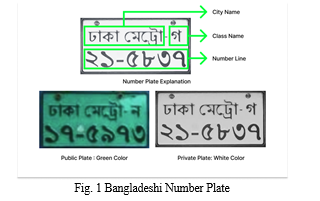
Our research aims to develop a YOLOv8 model tailored for recognizing Bengali license plates, addressing the challenges of vehicle license plate recognition in Bangladesh. This involves accurately localizing license plates, segmenting alphanumeric characters, and deciphering Bengali script. By integrating advanced deep learning techniques, we seek to enhance efficiency and accuracy in applications such as law enforcement and traffic management.
A. Existing Challenges
This research faces several existing challenges that underscore its significance and urgency. The burgeoning vehicle usage in Bangladesh, propelled by rapid population growth, exacerbates issues such as vehicle thefts, traffic violations, and accidents. Addressing these challenges requires effective vehicle number plate recognition systems to curb offenses and identify perpetrators. Moreover, the country's ongoing infrastructural projects, particularly in urban centers like Dhaka, contribute to pollution levels, necessitating enhanced measures for understanding and mitigating the environmental impact of vehicle emissions. Despite these pressing concerns, insufficient research has been conducted to develop robust solutions tailored to Bangladesh's unique context, highlighting the need for this study to fill the existing gap and provide valuable insights for future endeavors. Furthermore, overcoming challenges like recognizing plates in low-resolution images and on moving vehicles adds complexity to the research, emphasizing the importance of innovative approaches to tackle these obstacles effectively.
B. Research Objective
In this research, we aim to develop an advanced Automatic License Plate Recognition (ALPR) system tailored specifically for Bangladeshi license plates. The primary objective is to achieve accurate and efficient detection, localization, and recognition of license plates in real-time. Leveraging deep learning techniques, particularly YOLOv8, and integrating Roboflow for dataset annotation and augmentation, our goal is to address unique challenges faced in Bangladesh, including the complexities of Bangla characters and low-resolution CCTV images. Additionally, we aim to solve specific issues encountered in real-world scenarios. Firstly, by sourcing 90% of the training data from angular perspectives, we aim to excel in detecting license plates from corner angles across various vehicle types. Secondly, we seek to overcome challenges posed by the prevalent condition of Bangladeshi vehicles, often featuring broken or obscured license plates, by developing a system capable of accurately identifying license plates amidst such obstacles, including low-resolution images or adverse conditions like dust-covered plates. Lastly, our objective is to ensure exceptional performance in scenarios where multiple license plates are present, such as buses adorned with banners, by reliably detecting and identifying the correct license plate, thereby contributing significantly to improved road safety and traffic management. Through these endeavors, we aspire to provide valuable insights and methodologies to advance ALPR technology, with a strong emphasis on practical deployment in real-world contexts.
C. Key Features and Innovations
Key features and innovations of the proposed workflow include a comprehensive approach to dataset collection, annotation, and augmentation for Bangladeshi license plate detection and recognition. Leveraging Roboflow's labeling tools facilitates accurate annotation of license plate regions, while data augmentation enhances dataset diversity, ensuring robust model performance across various scenarios.
Exporting the labeled dataset in YOLOv8-compatible format streamlines model training, with fine-tuning tailored for accuracy. Integration of the trained model into applications enables real-time license plate detection, further augmented by Optical Character Recognition (OCR) for character recognition. System performance evaluation using a separate test dataset ensures reliability, culminating in the deployment of the integrated system for real-world license plate tasks. This holistic workflow combines cutting-edge tools and methodologies to achieve efficient and accurate Bangladeshi license plate detection and recognition.
II. LITERATURE SURVEY
A. Literature Review
Bangla license plate recognition systems employ sophisticated methodologies and cutting-edge techniques to accurately process and identify license plate data [4]. These systems encompass various modules, including pre-processing stages, character recognition algorithms, and vehicle registration authentication protocols. Notably, Convolutional Neural Networks (CNNs) play a central role in these systems, facilitating the detection and segmentation of Bengali license plate numbers with exceptional precision [5]. Moreover, template matching methods are employed to enhance character recognition accuracy [6], while Deep Convolutional Neural Network (DCNN) models are increasingly utilized for real-time recognition of both license plates and characters, ensuring swift and efficient processing [7]. The integration of advanced algorithms such as YOLO (You Only Look Once) and customized segmentation techniques has significantly enhanced the accuracy of license plate detection and localization, particularly tailored to the unique characteristics of Bangladeshi license plates [8].
Furthermore, the utilization of comprehensive datasets like NumtaDB, comprising an extensive collection of numerical images, provides invaluable resources for training CNN models and refining recognition algorithms [9]. Image processing methodologies, including transformations to the HVC color space, block division techniques, and histogram equalization, further optimize image contrast and streamline character segmentation processes [10]. In parallel, the application of efficient morphological operations and Sobel edge detection methods contributes to the precise identification of number plates, ensuring robust recognition performance across diverse scenarios [11].
Advanced feature extraction techniques, such as Discrete Cosine Transform (DCT) and Linear Discriminant Analysis (LDA), are instrumental in enhancing plate recognition accuracy, enabling nuanced analysis and classification of license plate data [12]. Furthermore, automatic number plate recognition (ANPR) systems demonstrate versatile applications, ranging from vehicle owner identification to multilingual character recognition, thereby highlighting the broad utility of these technologies in various domains [13].
The proposed algorithm, which integrates LDA and DCT feature extraction techniques, represents a significant leap forward in achieving higher recognition accuracy and efficiency [14]. Additionally, the successful implementation of number plate detection algorithms relies heavily on the availability of effective hardware and software components, underscoring the critical importance of robust infrastructure in supporting these sophisticated systems [15].
B. Background Study
The field of Automatic License Plate Recognition (ALPR) has witnessed significant advancements in recent years, driven by the increasing demand for efficient traffic management systems. Various research endeavors have been undertaken to develop robust ALPR systems tailored to specific regions and languages, including Bengali-speaking areas such as Bangladesh.
Onim et al. [16] introduced BLPnet, an end-to-end Deep Neural Network (DNN) model designed explicitly for ALPR with a focus on Bengali characters. This model offers a computationally efficient solution, incorporating a cascaded architecture for accurate vehicle region detection. Leveraging a Convolutional Neural Network (CNN)-based Bengali OCR engine, BLPnet achieves impressive license plate recognition accuracy of 95% with enhanced speed.
Saif et al. [17] presented an ALPR system dedicated to Bangla license plates, employing Convolutional Neural Networks (CNNs) for both license plate detection and number recognition. Their system achieved an impressive accuracy of 99.5% on 200 images and demonstrated real-time processing capabilities.
Al Nasim et al. [18] proposed a hybrid approach for ALPR focused on Bangladeshi vehicles, integrating the YOLO model for license plate detection and a CNN model for character recognition. This approach ensures accurate and automated license plate detection, addressing various applications such as tracking and billing systems.
Rahman et al. [19] highlighted the dominance of Convolutional Neural Networks (CNNs) in computer vision and machine learning, introducing a CNN-based Bangla License Plate Recognition System (BLPRS) with improved accuracy suitable for various applications.
Pervej et al. [20] presented an efficient method for real-time computer vision-based recognition of Bangla vehicle license plates, demonstrating promising results with a recognition accuracy of 96.62%.
Dhar et al. [21] outlined a system design for implementing ALPR specifically tailored for Bangladeshi License Plates, achieving remarkable accuracy in recognition through stages of plate detection, shape verification, tilt correction, and character recognition using CNNs.
Haque et al. [22] addressed the challenge of ALPR systems functioning effectively with low-resolution license plate images, proposing an approach utilizing Enhanced Super Resolution Generative Adversarial Networks (ESRGANs) to upscale LR images and enhance recognition performance.
Ahmed et al. [23] proposed a cascaded architecture leveraging YOLOv7 for license plate detection and a custom Bangla OCR engine for character recognition, achieving high accuracy in both tasks and showcasing potential for enhancing road safety and traffic management.
Hasan and Alam [24] developed a multi-stage deep learning pipeline for Automatic Bangla License Plate Recognition, achieving significant improvements in accuracy and computational efficiency compared to previous methods.
Sarif et al. [25] introduced an end-to-end license plate recognition system tailored for Bangladeshi vehicles, achieving high accuracy in character recognition and contributing to the development of a diversified dataset for further research.
Rahman et al. [26] presented a real-time end-to-end ALPDR system for Bangladeshi vehicles, demonstrating high accuracy in license plate detection, segmentation, and recognition across diverse environmental scenarios.
Onim et al. [27] introduced a YOLOv4-based object detection model trained for detecting Bangladeshi vehicle license plates, operating at an average of 14 frames per second on real-time video footage.
Nasim et al. [28] focused on fog-resilient Bangla car plate recognition using the Dark Channel Prior (DCP) fog-dehazing technique, showcasing potential for enhancing transportation safety in challenging conditions.
Chowdhury et al. [29] implemented an ALPR system powered by ResNet50 for Bangla License Plate Detection and OCR, achieving high accuracies and precision with minimal error rates.
Tusar et al. [30] detailed the implementation of an ALPR system using MATLAB Image Processing Toolbox and ResNet50, demonstrating high accuracy in license plate detection and character recognition.
These research endeavors collectively contribute to the advancement of ALPR systems tailored for Bengali-speaking regions, addressing various challenges and demonstrating promising results for real-world applications.
III. RESEARCH METHODOLOGY
Our proposed methodology leverages YOLOv8, the latest iteration of Ultralytics' renowned real-time object detection and image segmentation model. YOLOv8 stands at the forefront of deep learning and computer vision advancements, delivering unmatched speed and accuracy. Its streamlined architecture ensures versatility across diverse applications and seamless integration with a range of hardware platforms, spanning from edge devices to cloud APIs.
Roboflow offers a comprehensive framework for creating computer vision models without the need for hand-labeling images. By utilizing big, slow foundation models to train small, fast supervised models, Roboflow ensures efficient model development and deployment. Its production-ready inference server supports various model architectures and fine-tuned models, making it easy to deploy computer vision solutions. With secure role-based access, Roboflow ensures data safety while enabling organizations to augment labeling capacity internally or through Roboflow Labeling. Committed to strict security and privacy standards, Roboflow provides a range of advantages, including open-source availability and user-friendly design tailored to individuals with varying technical expertise. Whether for personal or professional use cases, Roboflow equips users with the tools needed to label, train, and deploy computer vision solutions effectively.
By leveraging the capabilities of Roboflow alongside the power of YOLOv8, a comprehensive solution for Bangladeshi license plate detection and recognition can be developed. Roboflow streamlines the process by offering an intuitive interface for dataset creation, annotation, and augmentation, ensuring a diverse and well-labeled dataset. This dataset can then be seamlessly integrated with YOLOv8, taking advantage of its state-of-the-art object detection capabilities. Through fine-tuning and training on the annotated dataset, the YOLOv8 model can be optimized for accurate license plate detection in various conditions.
Furthermore, by implementing OCR for character recognition on the detected license plates, the system can achieve full license plate recognition functionality. The integrated solution holds promise for applications in traffic management, security, and law enforcement, offering a robust and efficient way to handle Bangladeshi license plate tasks.
A. Workflow
To integrate Roboflow with YOLOv8 for Bangladeshi license plate detection and recognition we will follow this workflow on Fig. 1:
- Collect a diverse dataset of Bangladeshi license plate images.
- Annotate license plate regions using Roboflow's labeling tools.
- Enhance dataset diversity through Roboflow's data augmentation.
- Export the labeled dataset in YOLOv8-compatible format.
- Train the YOLOv8 model on the dataset, fine-tuning for accuracy.
- Integrate the trained model into your application for real-time detection.
- Implement Easy-OCR for character recognition on detected license plates.
- Evaluate system performance with a separate test dataset.
- Deploy the integrated system for real-world license plate tasks.
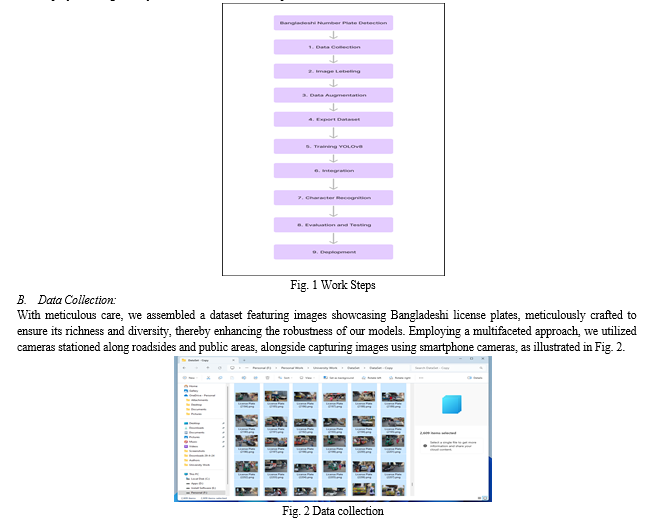
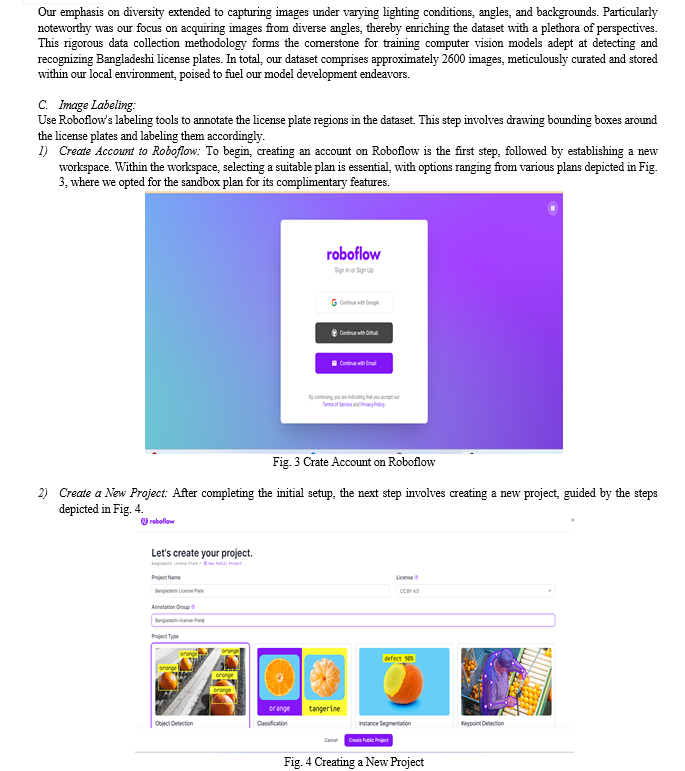
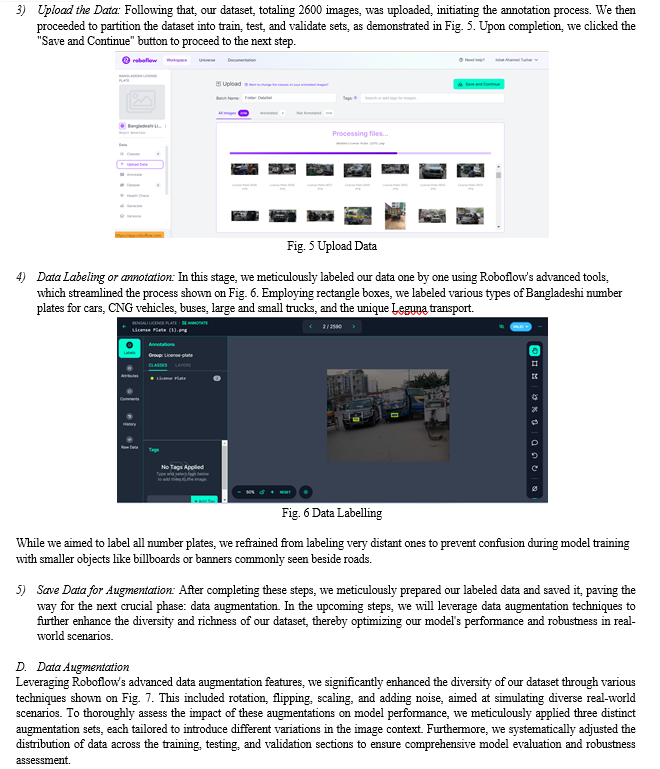
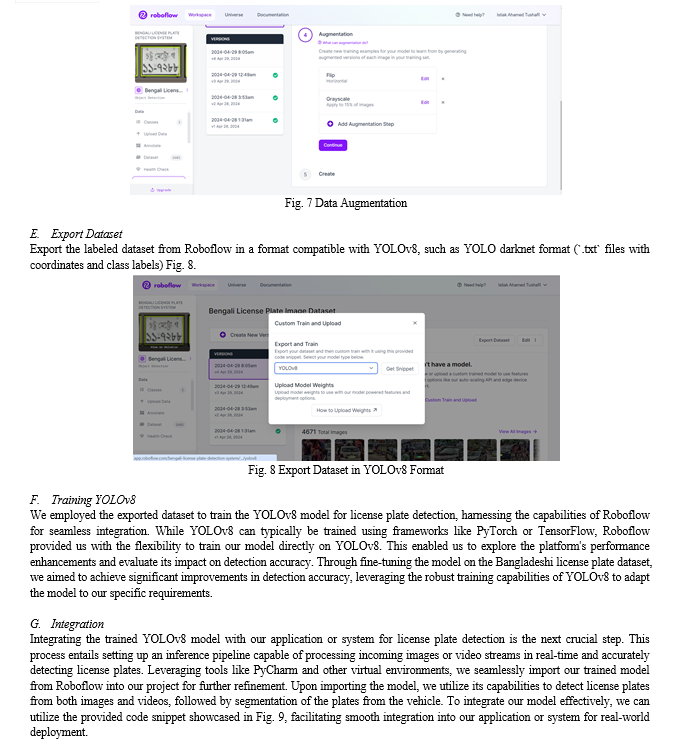
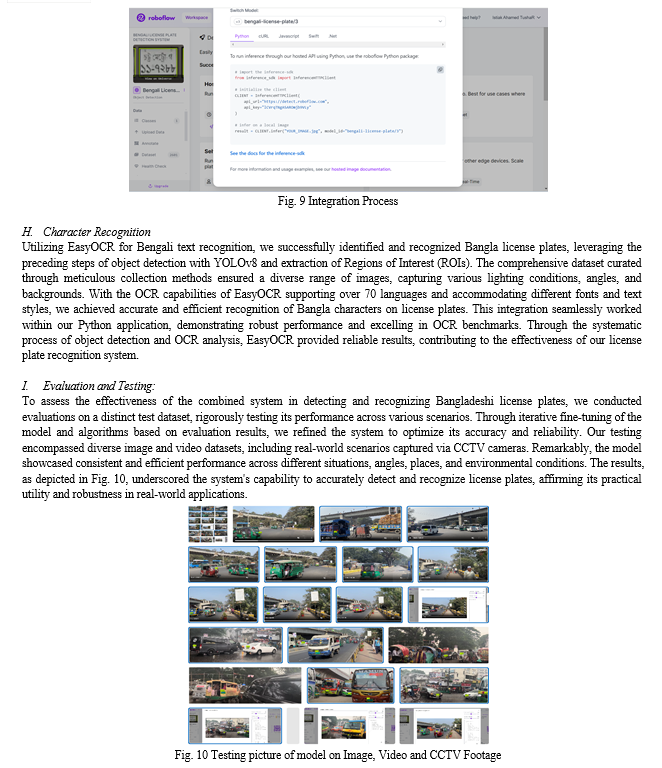
J. Deployment
The development process of our system commenced with meticulous dataset curation, gathering images of Bangladeshi license plates from various sources to ensure diversity in conditions and contexts. Through robust annotation and segmentation using Roboflow, the dataset was prepared for YOLOv8 model training, augmented for enhanced diversity and accuracy. Integration into our application facilitated real-time license plate detection, with PyCharm serving as the seamless platform for model deployment. Extensive testing validated the model's efficiency across diverse scenarios, confirming its reliability in detecting and recognizing license plates with precision. These results underscored the system's practicality and potential for deployment in real-world applications such as traffic management and security systems.
IV. RESULT AND DISCUSSION
We meticulously crafted three distinct datasets through the augmentation of our collected data, employing techniques such as rotation, flipping, scaling, and noise addition to emulate diverse real-world scenarios. Each dataset was meticulously tailored to introduce unique variations in the image context, allowing for a comprehensive assessment of their impact on model performance. Moreover, we systematically adjusted the distribution of data across the training, testing, and validation sections to ensure thorough model evaluation and robustness assessment. The results of our tests, including model performance based on the type of dataset and augmentation, as well as the segmentation of data into training, testing, and validation sets, are summarized comprehensively in TABLE 1, providing valuable insights into the effectiveness of our approach.
TABLE I
|
|
Information and Result for prepared dataset |
||
|
Dataset 1 |
Dataset 2 |
Dataset 3 |
|
|
Size of Dataset |
Total Images: 2601 Train Set: 1820 Valid Set: 521 Test Set: 260 |
Total Images: 7091 Train Set: 6735 Valid Set: 253 Test Set: 103 |
Total Images: 5595 Train Set: 5074 Valid Set: 521 Test Set: 260 |
|
Preprocessing
|
Auto-Orient: Applied Resize: Stretch to 640x640
|
Auto-Orient: Applied |
Auto-Orient: Applied Auto-Adjust Contrast: Using Adaptive Equalization |
|
Augmentations
|
No augmentations were applied. |
Rotation: Between -15° and +15° Grayscale: Apply to 15% of images Bounding Box: Rotation: Between -15° and +15° Bounding Box: Shear: ±10° Horizontal, ±10° Vertical Bounding Box: Brightness: Between -15% and +15% Bounding Box: Noise: Up to 0.34% of pixels
|
Flip: Horizontal, Vertical Grayscale: Apply to 15% of images
|
|
Training Model |
Model Type: Roboflow 3.0 Object Detection (Fast) (YOLOv8) Checkpoint:COCO |
Model Type: Roboflow 3.0 Object Detection (Fast) (YOLOv8) Checkpoint: COCOn
|
Model Type: Roboflow 3.0 Object Detection (Fast) (YOLOv8) Checkpoint:bengali-license-plate/1 (Model created by Dataset 1)
|
|
Result |
mAP: 94.0% Precision: 89.4 Recall: 90.8% |
mAP: 94.7% Precision: 94.7% Recall: 86.7% |
mAP: 94.8% Precision: 94.5% Recall: 87.9% |
During the training of the YOLOv8 model, the generated training graph provides essential insights into its performance metrics, including Mean Average Precision (mAP), Box loss, Class loss, and Object Loss, as depicted in Fig. 11. This graph enables a comparative analysis of Dataset 1, 2, and 3, offering a detailed understanding of the model's behavior across different datasets.
Examining the training graph for Dataset 1, we observe consistent and favorable trends in performance metrics. The mAP values reflect the model's ability to achieve high precision and recall rates, indicating its proficiency in accurately detecting and recognizing license plates. Concurrently, the Box loss, Class loss, and Object Loss demonstrate stable and minimal fluctuations, signifying effective optimization and convergence during the training process.
Comparatively, analyzing the training graphs for Dataset 2 and 3 allows for assessing the model's adaptability to varying data distributions and conditions. Any discrepancies or deviations in performance metrics between datasets provide valuable insights into the model's robustness and generalization capabilities.
Overall, the comparative analysis facilitated by the training graph aids in understanding how the YOLOv8 model responds to different datasets, thereby guiding further refinement and optimization efforts. By identifying trends and patterns in performance metrics across datasets, we can make informed decisions to enhance the model's efficacy and suitability for real-world ALPR applications.
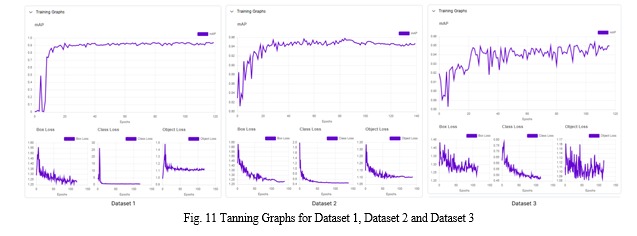
After training the YOLOv8 model, we meticulously evaluated its performance using a combination of matrices and graphs derived from the training process showcases the comprehensive metrics obtained from post-testing on Roboflow, offering valuable visual insights into the model's proficiency, particularly when subjected to real-world testing conditions. In the results discussion for Dataset 1, following the training of the YOLOv8 model, we conducted meticulous evaluations to assess its performance. Utilizing a combination of matrices and graphs derived from the training process, we obtained comprehensive metrics, as illustrated in Fig. 11. These metrics, obtained from post-testing on Roboflow, provide valuable visual insights into the model's proficiency, particularly when subjected to real-world testing conditions.
Regarding the first point, the model's exceptional performance in detecting license plates from corner angles, especially evident in Dataset 1, underscores its robustness. This proficiency in corner-side detection, derived from a significant portion of angular data during training, demonstrates the model's adaptability to diverse vehicle orientations commonly encountered in real-world scenarios.
Moreover, Dataset 1's results also highlight the model's capability to accurately identify license plates amidst challenging conditions prevalent in Bangladeshi settings.
Despite the common occurrence of broken or obscured license plates, the model exhibits consistent accuracy, showcasing its resilience to such obstacles. This capability extends to scenarios involving low-resolution images, dust-covered plates, and other adverse conditions, further validating the model's effectiveness in practical applications.
Lastly, the model's performance on Dataset 1 reaffirms its ability to handle situations with multiple license plates, as often encountered on vehicles like buses adorned with banners. Even amidst cluttered environments, the model reliably distinguishes and identifies the correct license plate, underscoring its potential for enhancing road safety and traffic management.
In conclusion, the evaluation results for Dataset 1 serve as a testament to the YOLOv8 model's efficacy and suitability for real-world ALPR applications in Bangladesh. The model's exceptional performance, as evidenced by comprehensive metrics and visual representations, validates its reliability and underscores its potential to address the unique challenges posed by Bangladeshi license plates in diverse operational environments.
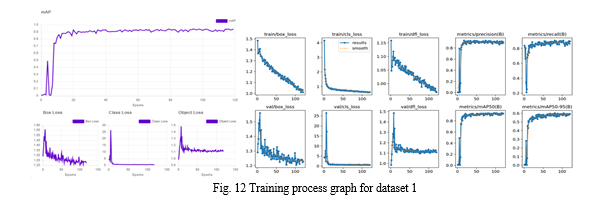
VI. FUTURE WORK
Future work in this research direction could focus on several key areas to advance the capabilities and practicality of the developed ALPR system for Bangladeshi license plates. Firstly, there's potential for enhanced model training by continually refining and optimizing the YOLOv8 model to achieve greater detection accuracy and robustness across varying environmental conditions and vehicle types. Dataset expansion is another avenue, where including a more diverse range of license plate images captured under different circumstances could bolster the model's generalization capabilities. Refining localization and segmentation techniques could further improve the system's ability to accurately identify and extract license plate regions from complex backgrounds.
Exploring the integration of multimodal information, such as vehicle speed and context data, could enrich the system's understanding and decision-making capabilities. Additionally, optimizing real-time performance and ensuring compliance with evolving regulatory standards are critical considerations. Field testing in real-world scenarios and designing user-friendly interfaces would provide valuable insights into system performance and facilitate widespread adoption. Addressing these aspects would refine the ALPR system's effectiveness and adaptability for various applications in traffic management, law enforcement, and urban planning contexts.
Conclusion
In summary, this research introduces a comprehensive framework tailored for developing a highly effective Automatic License Plate Recognition (ALPR) system specifically designed for Bangladeshi license plates. By leveraging advanced deep learning techniques like YOLOv8 and harnessing the capabilities of Roboflow for dataset annotation and augmentation, a robust solution has been crafted capable of accurately detecting and recognizing Bangladeshi license plates in real-time. The methodology employed emphasizes three key points: Firstly, 90% of the data utilized in training was sourced from angular perspectives, enabling the model to excel in detecting license plates from corner angles across various vehicle types. Secondly, given the prevalent condition of Bangladeshi vehicles, often featuring broken or obscured license plates, the system\'s ability to discern and accurately identify license plates amid such challenges is noteworthy. Even amidst low-resolution images or adverse conditions, such as dust-covered plates, the model exhibits remarkable proficiency. Lastly, the model demonstrates exceptional performance in scenarios where multiple license plates are present, as commonly seen on buses adorned with banners. Despite the cluttered environment, the system reliably detects and identifies the correct license plate, contributing significantly to improved road safety and traffic management. In conclusion, this research offers valuable insights and methodologies to enhance ALPR technology, specifically addressing the unique challenges posed by Bangladeshi license plates. Its potential for real-world deployment in traffic management, security, and law enforcement applications signifies a substantial contribution to advancing road safety not only in Bangladesh but also in similar contexts worldwide.
References
[1] Worldometer. (n.d.). Bangladesh Population. Retrieved from https://www.worldometers.info/world-population/bangladesh-population/#:~:text=Bangladesh%202023%20population%20is%20estimated,(and%20dependencies)%20by%20population. [2] IDLC. (n.d.). Number of Registered Vehicles in Bangladesh. Retrieved from https://idlc.com/mbr/article.php?id=411#:~:text=According%20to%20BRTC%2C%20till%20August,4%2C808%2C715%20registered%20vehicles%20in%20Bangladesh. [3] Ullah, M. A. (2023). An Analysis of Crime Statistics of 6 Months (January-June, 2023). DOI: 10.13140/RG.2.2.31784.96008. [4] Islam, M.A., Chowdhury, G.M. and Haque, M.N.M., 2021, May. Bangla License Plate Detection, Recognition and Authentication with Morphological Process and Template Matching. In 2021 2nd International Conference for Emerging Technology (INCET) (pp. 1-6). IEEE. [5] Saif, N., Ahmmed, N., Pasha, S., Shahrin, M.S.K., Hasan, M.M., Islam, S. and Jameel, A.S.M.M., 2019, October. Automatic license plate recognition system for Bangla license plates using convolutional neural network. In TENCON 2019-2019 IEEE Region 10 Conference (TENCON) (pp. 925-930). IEEE. [6] Hossain, M.J., Uzzaman, M.H. and Saif, A.S., 2018. Bangla digital number plate recognition using template matching for higher accuracy and less time complexity. International Journal of Computer Applications, 975, p.8887. [7] Islam, T. and Rasel, R.I., 2019. Real-time Bangla license plate recognition system using Faster R-CNN and SSD: A deep learning application. In 2019 IEEE International Conference on Robotics, Automation, Artificial-intelligence and Internet-of-Things (RAAICON) (pp. 108-111). IEEE. [8] Sarif, M.M., Pias, T.S., Helaly, T., Tutul, M.S.R. and Rahman, M.N., 2020, October. Deep learning-based Bangladeshi license plate recognition system. In 2020 4th International Symposium on Multidisciplinary Studies and Innovative Technologies (ISMSIT) (pp. 1-6). IEEE. [9] Shovon, M.M.I., Kamruzzaman, M. and Kundu, M.K., 2020, June. Recognition of handwritten Bangla number using multi-layer convolutional neural network. In 2020 IEEE Region 10 Symposium (TENSYMP) (pp. 783-786). IEEE. [10] Azad, R., Davami, F. and Azad, B., 2013. A novel and robust method for automatic license plate recognition system based on pattern recognition. Advances in Computer Science: an International Journal, 2(3), pp.64-70. [11] Bailmare, S.H. and Gadicha, A.B., 2013. A review paper on Vehicle Number Plate Recognition (VNPR) using improved character segmentation method. International Journal of Scientific and Research Publications, 3(12), pp.1-3. [12] Roy, S., Choudhury, A. and Mukherjee, J., 2013. An approach towards detection of Indian number plate from vehicle. International Journal of Innovative Technology and Exploring Engineering (IJITEE), 2(4), pp.241-244. [13] Munuo, C.H., Michael, K. and Nvungi, N.H., 2014. Vehicle Plate Number Detection and Recognition Using Improved Algorithm. [14] Saif, N., Ahmmed, S. Pasha, M.S.K. Shahrin, M. Hasan, S. Islam, and, A.S.M.M. Jameel, \"Automatic License Plate Recognition System for Bangla License Plates using Convolutional Neural Network,\" TENCON 2019 - 2019 IEEE Region 10 Conference (TENCON), Kochi, India, 2019, pp. 925-930, doi: 10.1109/TENCON.2019.8929280. [15] Saif, N., Ahmmed, S. Pasha, M.S.K. Shahrin, M. Hasan, S. Islam, and, A.S.M.M. Jameel, \"Automatic License Plate Recognition System for Bangla License Plates using Convolutional Neural Network,\" TENCON 2019 - 2019 IEEE Region 10 Conference (TENCON), Kochi, India, 2019, pp. 925-930, doi: 10.1109/TENCON.2019.8929280. [16] Md. Saif Hassan Onim, Hussain Nyeem, Koushik Roy, Mahmudul Hasan, Abtahi Ishmam, Md. Akiful Hoque Akif, Tareque Bashar Ovi, \"BLPnet: A new DNN model and Bengali OCR engine for Automatic Licence Plate Recognition,\" Elsevier Inc., 2019. [Online]. Available: https://doi.org/10.1016/j.procs.2019.04.158. [Accessed: Date Accessed]. [17] Nazmus Saif, Nazir Ahmmed, Sayem Pasha, Md. Saif Khan Shahrin, Md. Mahmudul Hasan, Salekul Islam, and Abu Shafin Mohammad Mahdee Jameel, \"978-1-7281-1895-6/19/$31.00 c2019 IEEE,\" in 2019 IEEE Region 10 Conference (TENCON 2019). [18] Al Nasim, M. A., Chowdhury, A. I., Muna, J. N., & Shah, F. M. (2021). An Automated Approach for the Recognition of Bengali License Plates. In 2021 International Conference on Electronics, Communications and Information Technology (ICECIT) (pp. 1-4). Khulna, Bangladesh: Ahsanullah University of Science and Technology & United International University, Department of Computer Science and Engineering. [19] Rahman, M. M. S., Nasrin, M. S., Mostakim, M., & Alom, M. Z. (2018). Bangla License Plate Recognition Using Convolutional Neural Networks (CNN). Retrieved from https://www.researchgate.net/publication/327433805_Bangla_License_Plate_Recognition_Using_Convolutional_Neural_Networks_CNN [20] Pervej, M., Das, S., Hossain, M. P., Atikuzzaman, M., Mahin, M., & Rahaman, M. A. (2021). Real-Time Computer Vision-Based Bangla Vehicle License Plate Recognition using Contour Analysis and Prediction Algorithm. *International Journal of Image and Graphics*, 21(2), 2150042. DOI: 10.1142/S021946782150042X [21] Dhar, P., Guha, S., Biswas, T., & Abedin, Z. (2018). A System Design for License Plate Recognition by Using Edge Detection and Convolution Neural Network. In *International Conference on Computer, Communication, Chemical, Material and Electronic Engineering (IC4ME2)*. DOI: 10.1109/IC4ME2.2018.8465630. [22] Haque, N., Islam, S., Tithy, R. A., & Uddin, M. S. (2022). Automatic Bangla License Plate Recognition System for Low-Resolution Images. In *4th International Conference on Sustainable Technologies for Industry 4.0 (STI)* (pp. 1-4). Dhaka. [23] Ahmed, S. U., Maisha, F. B. F., & Haider, M. H. (2022). Bangla License Plate Detection and Recognition System with YOLOv7 and Improved Custom OCR Engine. *2022 Fourth International Conference on Emerging Research in Electronics, Computer Science and Technology (ICERECT)*. DOI: 10.1109/ICERECT56837.2022.10060446. [24] Hasan, M. (2020). \"Development of A Multi-Stage Deep Learning Pipeline for Automatic Bangla License Plate Recognition.\" Bachelor of Science thesis, Chittagong University of Engineering & Technology, Chattogram, Bangladesh. [25] Sarif, M. M., Pias, T. S., Helaly, T., Sohel, M., Tutul, R., & Rahman, N. (2020). \"Deep Learning-Based Bangladeshi License Plate Recognition System.\" In 2020 4th International Symposium on Multidisciplinary Studies and Innovative Technologies (ISMSIT) (pp. 1-6). Istanbul, Turkey: IEEE. DOI: 10.1109/ISMSIT50672.2020.9254748 [26] Rahman, R., Rakib, A. F., Rahman, M., Helaly, T., & Pias, T. S. (2021). \"A Real-time End-to-End Bangladeshi License Plate Detection and Recognition System for All Situations Including Challenging Environmental Scenarios.\" In 2021 5th International Conference on Electrical Engineering and Information & Communication Technology (ICEEICT) (pp. 1-6). DOI: 10.1109/ICEEICT53905.2021.9667896 [27] Onim, M. S. H., Akash, M. I., Haque, M., & Hafiz, R. I. (2020). \"Traffic Surveillance using Vehicle License Plate Detection and Recognition in Bangladesh.\" In 2020 11th International Conference on Electrical and Computer Engineering (ICECE) (pp. 1-5). arXiv:2012.02218v1 [cs.CV] 3 Dec 2020. [28] Nasim, H., Printia, F. J., Rashid, R., Himel, M. H., Chowdhury, I. J., Islam, M. F., & Noor, J. (2023). \"Fog-Resilient Bangla Car Plate Recognition using Dark Channel Prior and YOLO.\" In Proceedings of the 10th International Conference on Networking, Systems and Security (NSysS 2023). Dhaka, Bangladesh: BRAC University. DOI: 10.13140/RG.2.2.10681.13925 [29] Chowdhury, A. N., Chowdhury, G. M., Chowdhury, I. A., Hasan, M., Laskar, M. F. A., & Summit, S. P. (2024). \"ALPR: ResNet50 powered Bangla License Plate Detection and OCR by Root Mean Square Propagation Optimizer and Linear SVM Classifier.\" DOI: 10.13140/RG.2.2.16039.11681. License: CC BY 4.0. [30] Tusar, M. H., Bhuiya, M. T., Hossain, M. S., Tabassum, A., & Khan, R. (2022). \"Real Time Bangla License Plate Recognition with Deep Learning Techniques.\" DOI: 10.1109/IICAIET55139.2022.9936764. Presented at the 2022 IEEE International Conference on Artificial Intelligence in Engineering and Technology (IICAIET).
Copyright
Copyright © 2024 Ahamed Istiak, Wang Feng. This is an open access article distributed under the Creative Commons Attribution License, which permits unrestricted use, distribution, and reproduction in any medium, provided the original work is properly cited.

Download Paper
Paper Id : IJRASET61520
Publish Date : 2024-05-03
ISSN : 2321-9653
Publisher Name : IJRASET
DOI Link : Click Here
 Submit Paper Online
Submit Paper Online

